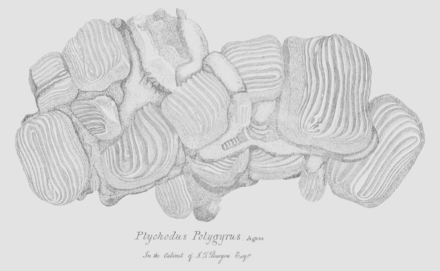Geology and Mineralogy considered with reference to Natural Theology/Plate 27f

Plate 27f . V. I. pp. 217 & 220.
Beautiful cluster of palatal teeth of Ptychodus polygyrus, from the Chalk. Insulated teeth of many species of this Genus abound throughout the Chalk formation. The mouth of these and all the other numerous extinct species of Sharks in the family of Cestracionts, was lined with a pavement of similar powerful teeth, forming a most efficient apparatus, for crushing the shells of Crustacea and Conchifera, which probably formed their principal food. The surfaces of the Enamel are often worn away, like that at Pl. 27 e . fig. 3. The strength and efficacy of these teeth, viewed as Instruments for crushing shells, is very remarkable. Beneath the Enamel, the body of each tooth is composed of a strong mass of bone. (Miss F. C. Burgon. Original.)
Plate 28. V. I. p. 230.